Mars Direct 3 offers a modular approach to solving the many challenges for a SpaceX Starship Mars mission. This includes the development of a new Mars lander -based on SpaceX’s Starship vehicle- to serve as the crewed ship, while keeping the Starship as a cargo ship, though a Starship-only approach is also considered. Mars Direct 3 has a paper that describes all of the steps.
NOTE: The NASA Moxie mission has validated Oxygen production on Mars. NASA plan is to produce 25 to 30 tons of oxygen in one year using about 25,000 to 30,000 watt of power plant. The Perseverance power system provided only about 100 watts. Moxie worked. Oxygen production was first achieved on April 20, 2021, in Jezero Crater, producing 5.37 grams (0.189 oz) of oxygen, equivalent to what an astronaut on Mars would need to breathe for roughly 10 minutes. MOXIE is designed to safely generate up to 10 g/h (0.35 oz/h) of oxygen, with theoretical production limited to 12 grams per hour (0.42 oz/h) of oxygen due to the limited capacity of the 4 ampere flight power supply. You send the Oxygen and Methalox production in an unmanned mission and then you send people. The people will be greeted on Mars with full fuel tanks of oxygen and methalox and deployed solar power. It would be foolish to try to produce oxygen and fuel after humans arrive no Mars.
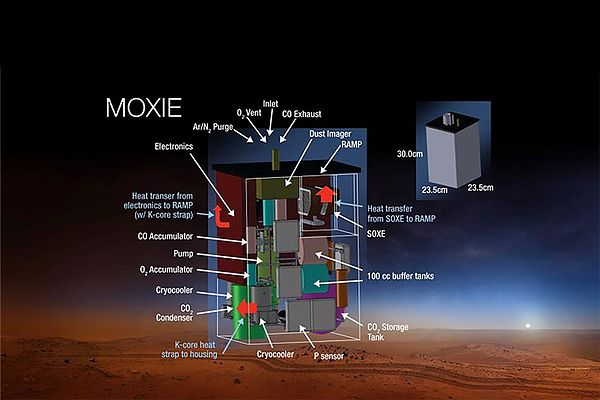
ISRU (In Situ Resource Utilization) is to reduce the mass and cost of systems. You can alway bring what you cannot generate with ISRU. ISRU makes sense when it reduces the mass of the mission. You can always make a bigger mission especially if SpaceX Starship reduces the cost of flying to space by 10 to 100 times. It is a question of cost. An oxygen only ISRU plan means you have to bring other materials. It is a question of cost and not feasability.
Mars Direct 3 accounts for four vehicles launched to the surface of Mars within the timeframe of two launch windows, one of them with a crew of 6 astronauts set to stay on Mars for one and a half years and depart to Earth with locally produced fuel. There are also Starship only plans.
With safety being the primary goal, the plan is built with a number of back-ups and contingency plans to account for the failed landing of three of the four ships, month-long global dust storms, crash landings, failed ISRU and other incidents that may occur, while still returning astronauts safely to the Earth.
In 2019, Dr. Robert Zubrin presented Mars Direct 2, a modification of SpaceX’s plan suggesting the use of the Starship system as a heavy launch vehicle to launch a different -smaller- vehicle to Low Earth Orbit or a highly elliptical orbit nearing Earth escape. This smaller ship would finish the trans-Mars injection and land there.
This high orbit alternative would require on-orbit refueling and would still allow the smaller vehicle to deliver a significant payload to the surface of Mars. (Zubrin, 2019)
The main reason for this change is to reduce the amount of power required to create the fuel needed for the return to Earth. The proposed “Mini-Starship” would require around a factor of five less fuel while delivering, in the elliptical orbit configuration, around a third of the cargo.
Pioneer Astronautics demonstrated a reactor capable of producing 1 Kg a day of methalox fuel from hydrogen and carbon dioxide while consuming a power of 700W. For 710 tons in 400 days that is 1.89 MW. (Zubrin et al., 2013). Assuming 400 days to produce the 710 tons of fuel needed, 352 tons of water (for electrolysis) and 1.89 MW of power would be needed. Using the methods and assumptions detailed (including a 20% margin for safety), the solar infrastructure would be:
• 229.2 tons in mass.
• 3437.4 cubic meters in volume.
• 57290.1 square meters in area.
If nuclear energy is not available for this mission, solar energy is the only alternative. These panels have to be deployed, maintained and cleaned for long periods of time. But what is the mass, area and volume of the panels needed?
For the calculation, the following assumptions are made:
• 0.5862 KW per square meter of solar irradiance.
• Night loss of 50%.
• Losses due to weather and latitude of 55%.
• 30% efficiency of panels.
• 4 Kg per square meter of panel.
• Panel thickness of 5 cm.
• 20% margin added to mass and volume for stacking and other uncertainties.
The result is 24.8 tons of panels, covering an area of 6209.4 m2. When stacked inside of the Starship, they would occupy 372.6 m3 of the estimated 650 m3 volume of the Starship cargo bay. For Starship, this would be 98 tons, 24501 m2 and 1225 m3 respectively.
By using the Caravel as well as Starship, the fuel requirement is for the former while the cargo capacity is that of the latter.
This means that the panels impose a proportionately smaller mass penalty on the mission. What had to be delivered in three launches can now be delivered in one, with room and mass to spare.
Mars Direct 3 Starship-only version.
An operation on Mars 4 times the scale would require increasing the labor force. With science not depending on the scale, this mission would require 10 to 15 astronauts. With the uncertainties associated with the first missions, this means risking more lives. Requiring three more critical landings and twice the amount of launches would also decrease the chance of mission success. On the other hand, the same or equivalent versions of most of the contingency plans explored for a Caravel & Starship approach would be viable.
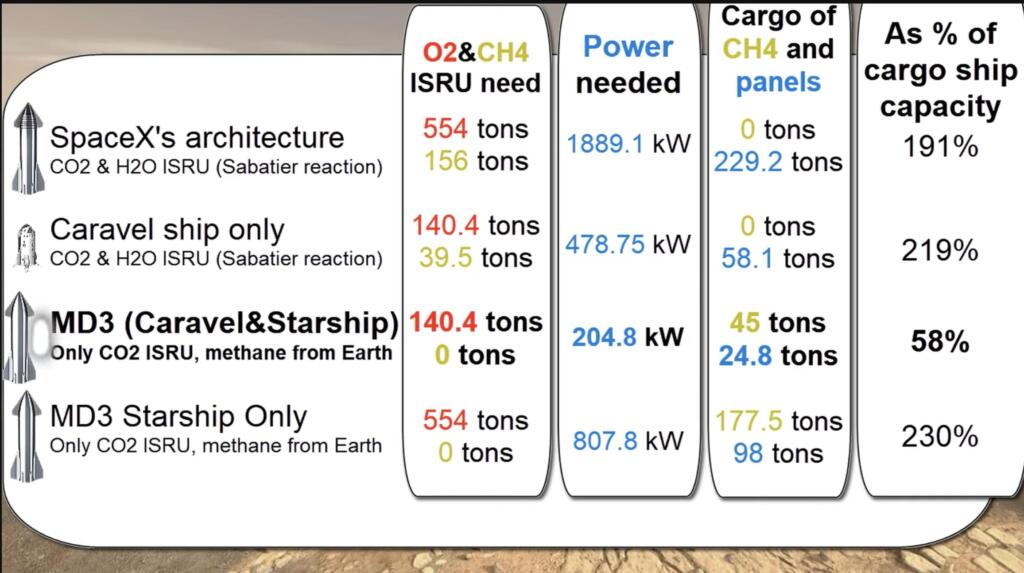


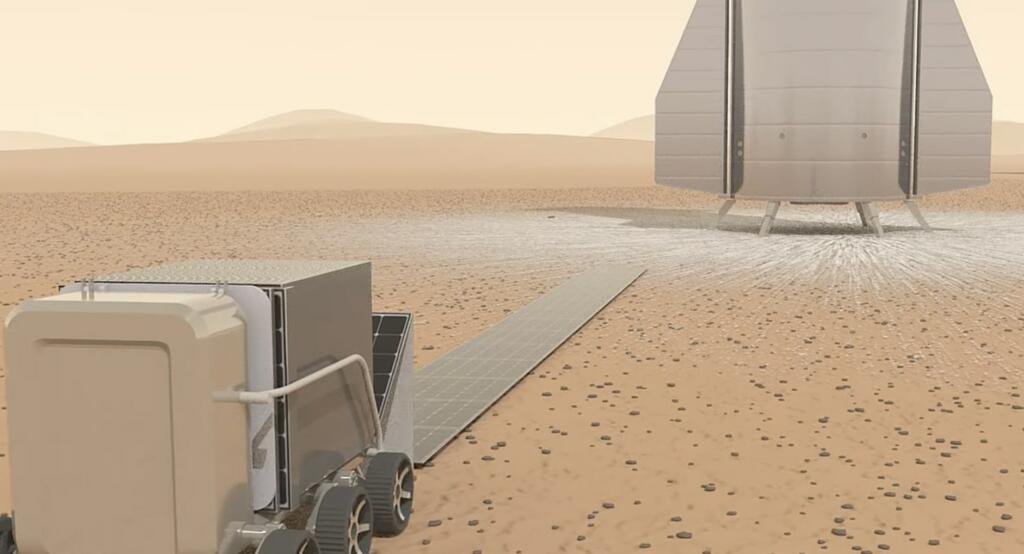

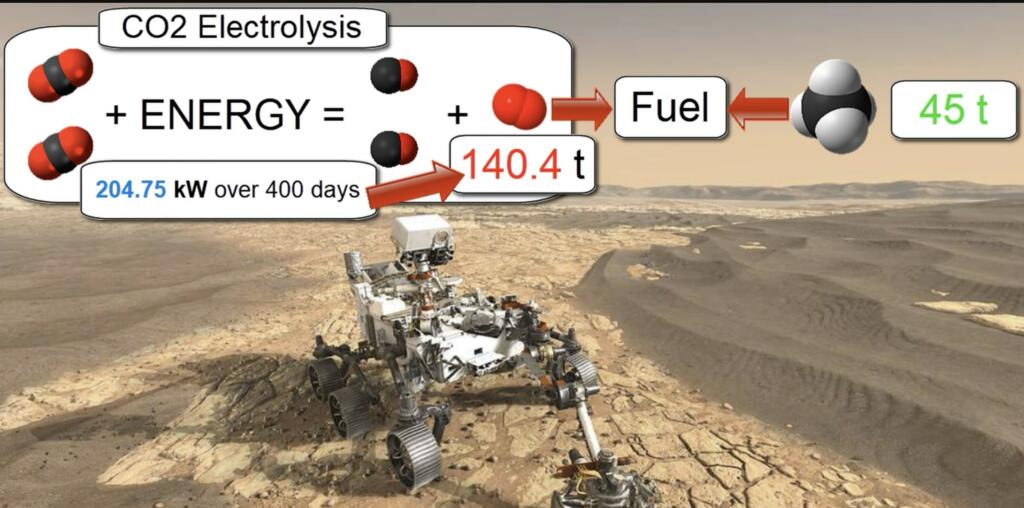
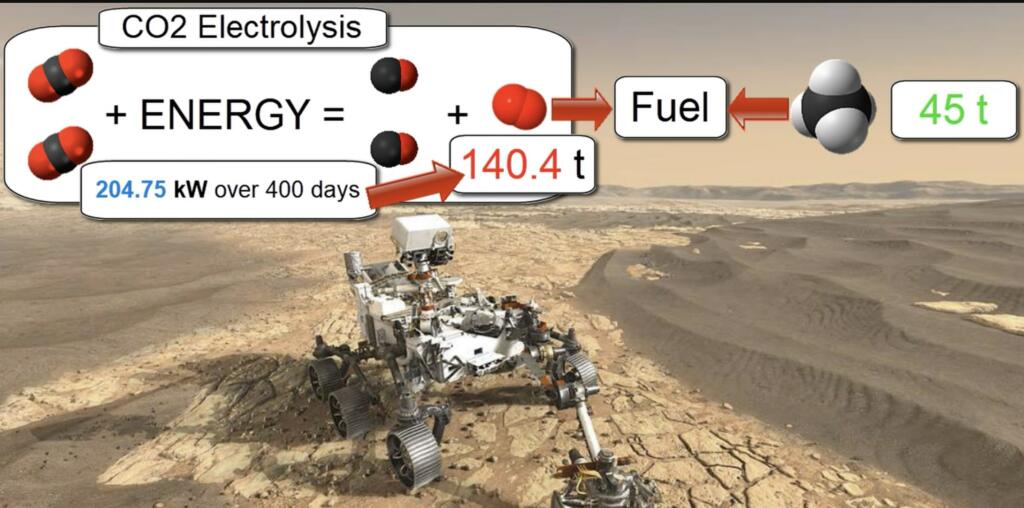
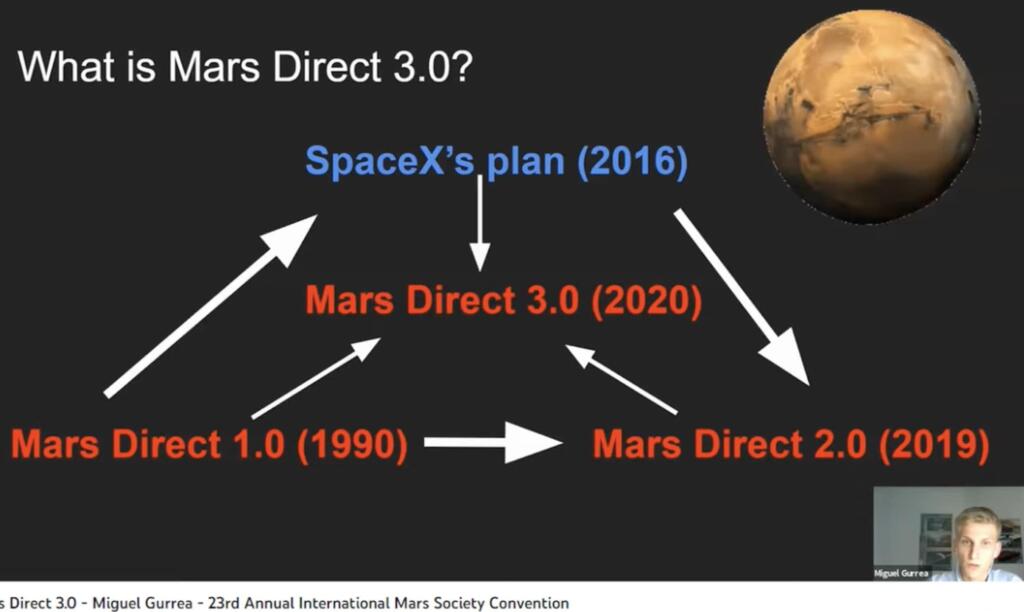

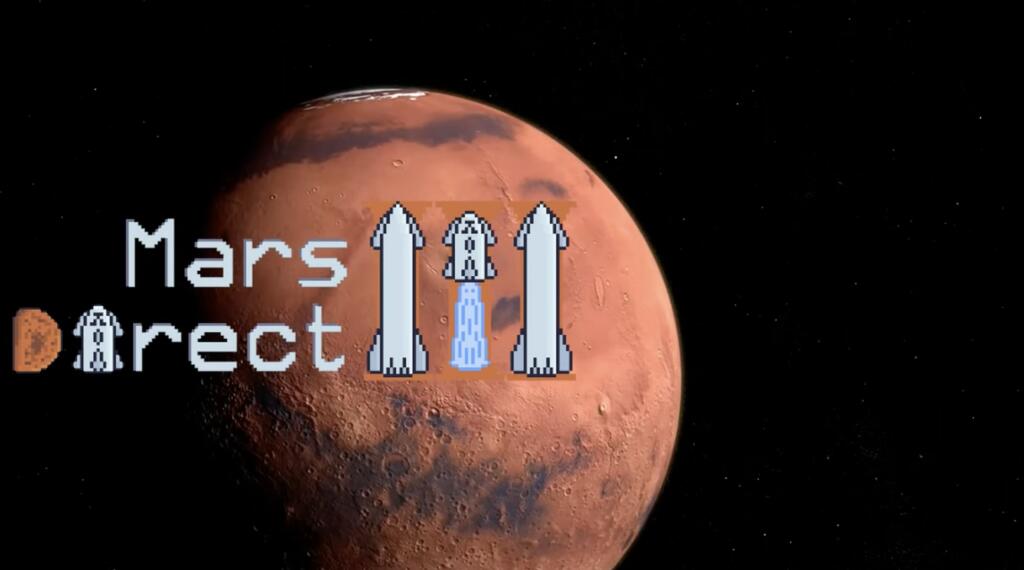




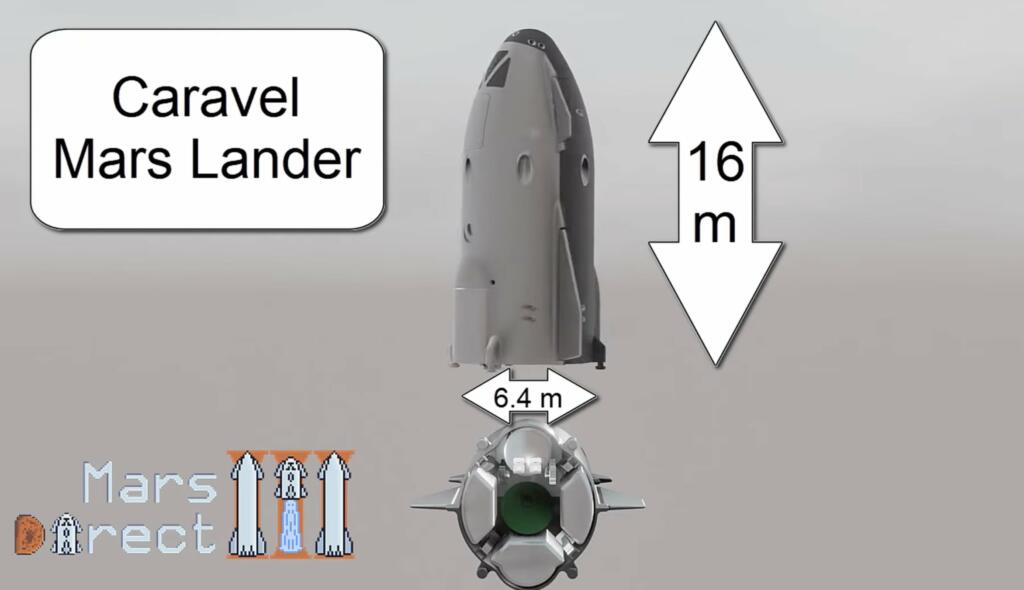


Alternative Paper Examining Bioproduction of Mars Rocket Propellent
Mars colonization demands technological advances to enable the return of humans to Earth. Shipping the propellant and oxygen for a return journey is not viable. Considering the gravitational and atmospheric differences between Mars and Earth, researchers propose bioproduction of a Mars-specific rocket propellant, 2,3-butanediol (2,3-BDO), from CO2, sunlight and water on Mars via a biotechnology-enabled in situ resource utilization (bio-ISRU) strategy. Photosynthetic cyanobacteria convert Martian CO2 into sugars that are upgraded by engineered Escherichia coli into 2,3-BDO. A state-of-the-art bio-ISRU for 2,3-BDO production uses 32% less power and requires a 2.8-fold higher payload mass than proposed chemical ISRU strategies, and generates 44 tons of excess oxygen to support colonization. Attainable, model-guided biological and materials optimizations result in an optimized bio-ISRU that uses 59% less power and has a 13% lower payload mass, while still generating 20 tons excess oxygen.
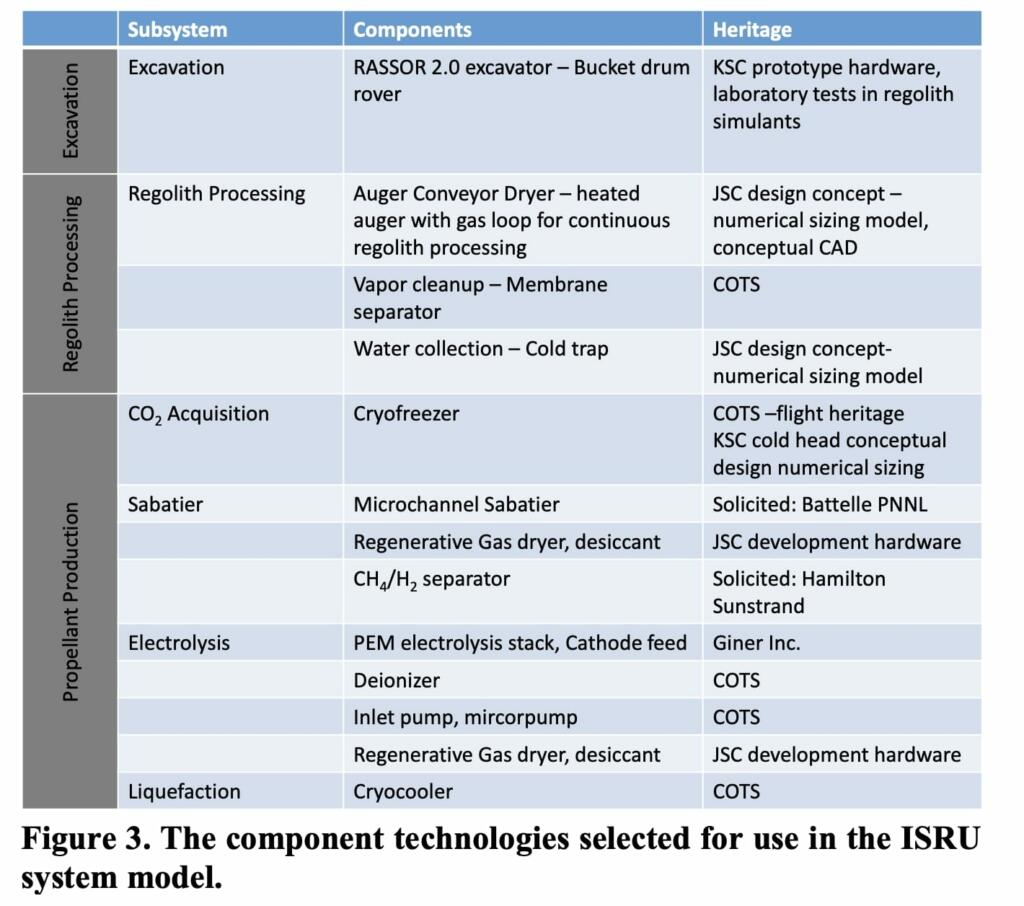
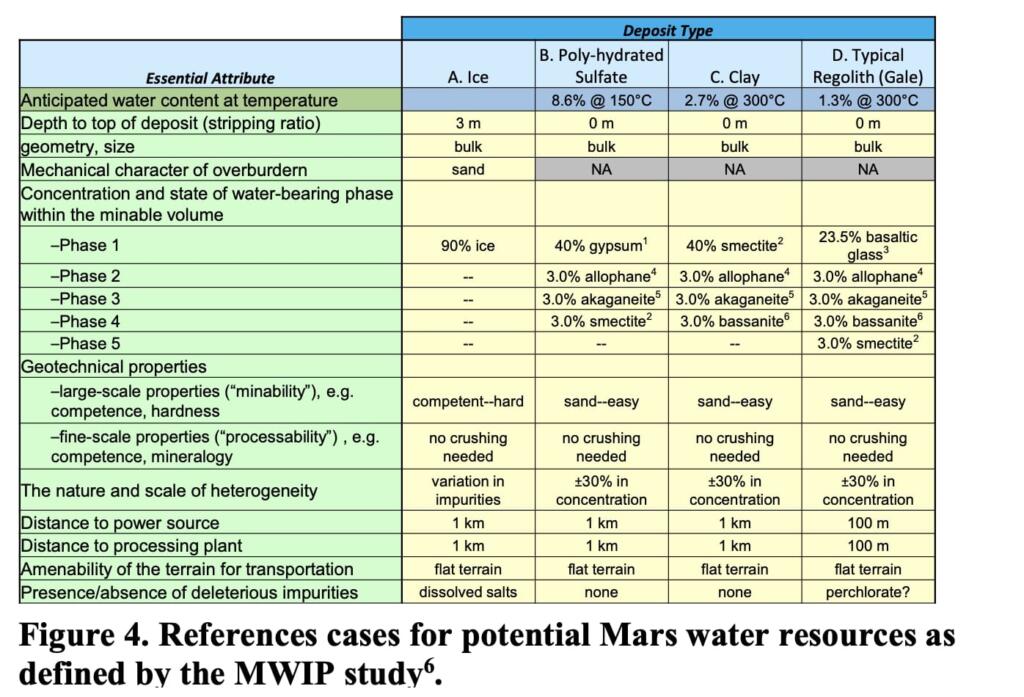

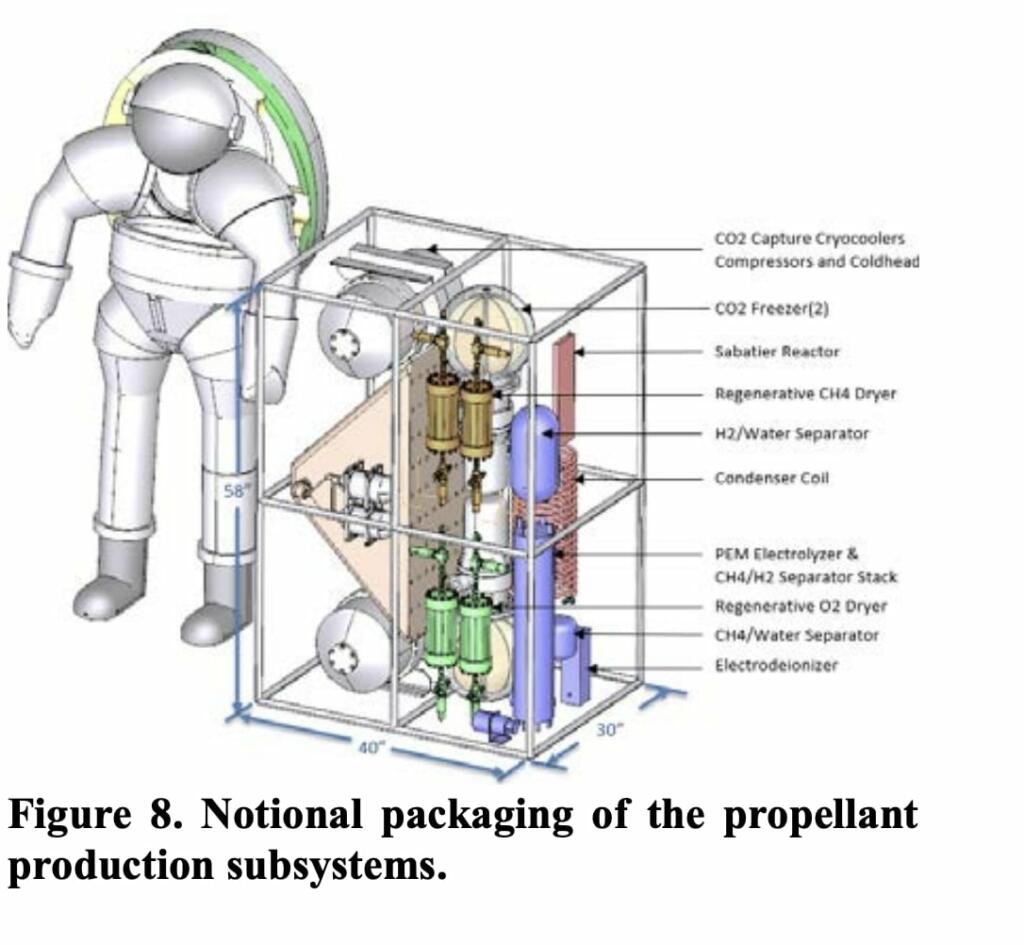

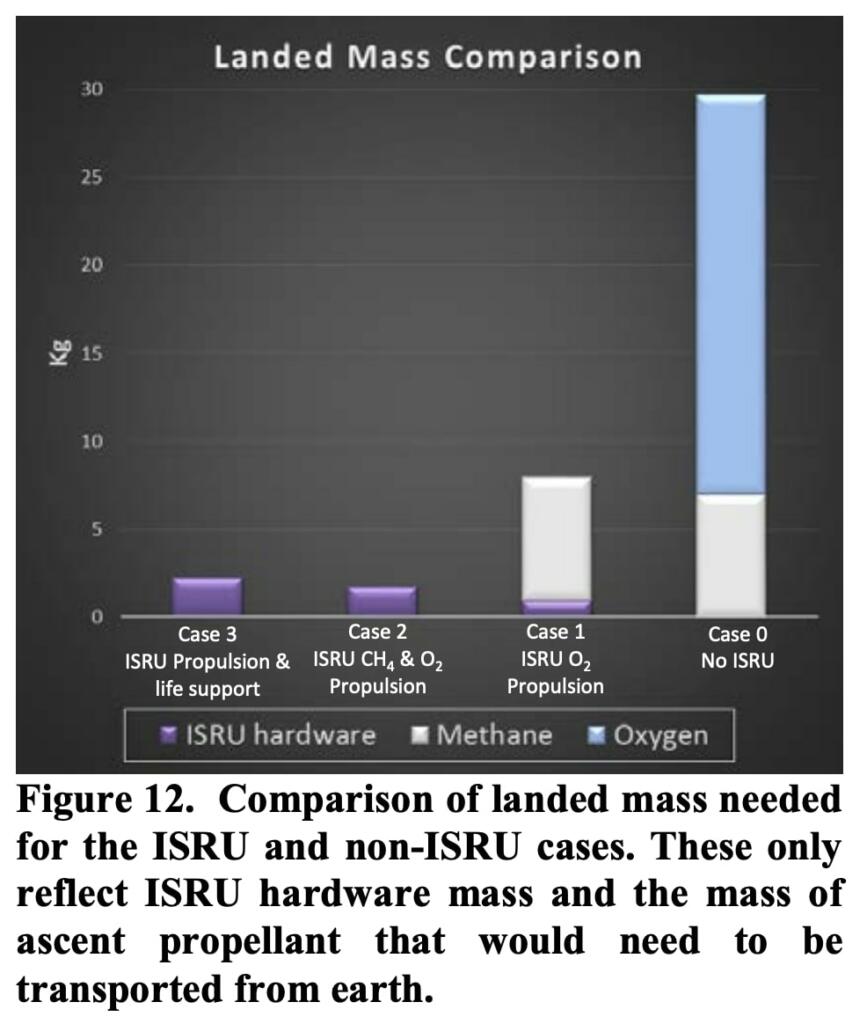

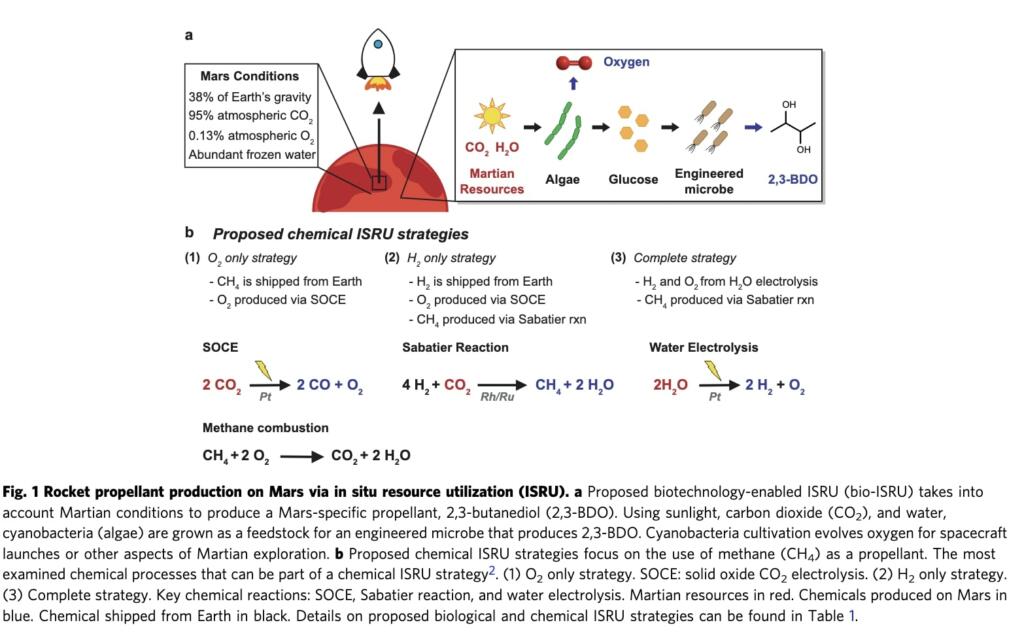

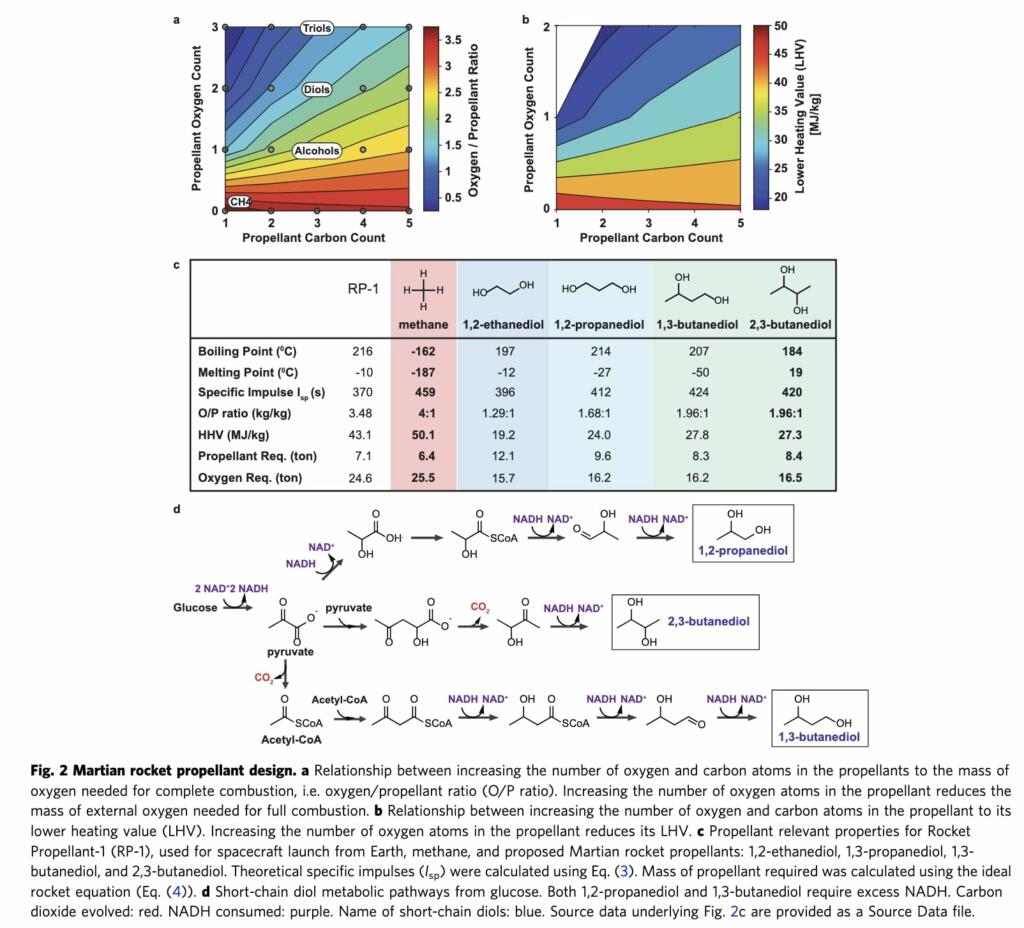
Reducing the number of unit operations or recycling of nitrogen and phosphorus could further improve the bio-ISRU metrics. For example, the enzymatic digestion step could be completely eliminated by engineering cyanobacteria to not store glycogen, but instead secrete glucose or sucrose directly to the media. Such an approach would eliminate the enzymatic digestion step and the need to ship digestive enzymes from Earth. In the biologically optimized scenario, cyanobacterial growth will consume 1.19 kg of nitrogen and 0.143 kg of phosphorus per day. A 3-day supply of nutrients, giving ample time for nitrogen and phosphorus to recycle through the enzyme digester, fermenter, and water treatment unit operations could reduce diammonium phosphate and ammonia requirement from 1.23 to 0.004 tons (3.6 kg). Researchers do not include this process optimization in our calculations as the proposed biological and materials improvements result in an energy requirement and payload mass that is lower than the DRA 5.0 O2 only strategy.
Current NASA Planetary Protection guidelines prohibit the sending of microbes to the surface of Mars to protect it from contamination by Earth life. As shown in this work, biotechnology applications on Mars have the potential to provide distinct advantages over chemical processes, including chemical production and oxygen generation. Towards Martian bio-ISRU approaches, physical containment barriers, as well as engineered biological containment strategies, will need to be implemented and fully tested on Earth before launching a mission to Mars. Engineering of kill switches and auxotrophic strategies to prevent microbes from surviving outside the reactor is an active area of research. Integrating Mars-specific features may lead to the development of microbes with a lower risk for Mars contamination.

Brian Wang is a Futurist Thought Leader and a popular Science blogger with 1 million readers per month. His blog Nextbigfuture.com is ranked #1 Science News Blog. It covers many disruptive technology and trends including Space, Robotics, Artificial Intelligence, Medicine, Anti-aging Biotechnology, and Nanotechnology.
Known for identifying cutting edge technologies, he is currently a Co-Founder of a startup and fundraiser for high potential early-stage companies. He is the Head of Research for Allocations for deep technology investments and an Angel Investor at Space Angels.
A frequent speaker at corporations, he has been a TEDx speaker, a Singularity University speaker and guest at numerous interviews for radio and podcasts. He is open to public speaking and advising engagements.


You see, it’s a reason for jealousy because politicians and salary people are not caring for their mother-earth then you show us that space is beautiful, but, but earth in Ludhiana Punjab India s dirty, it’s cause a pain. Yes true.
In New Janta Nagar Ludhiana Punjab India, residential area, but industry owner dull father and dull son are throwing debris from the 2nd floor in the tractor trolleys in the street passage, donating huge dust pollution and noise pollution for the last one month, Ludhiana municipal salary people are unable to see with their 2, 2 eyes… Innocent Voters souls are suffering.
The prime challenge of huge space structure is lifting its mass from Earth surface, it’s not the size of the structure.
Also mars sync orbit is 13,634 km high from surface, almost 1/3, not around 1/2. Plus we can choose much higher power density on Mars than on Earth, at least initially.
Thanks very much for posting this! I featured this plan in a video a couple of years ago, and interviewed Miguel on my channel as well.
The plan has evolved quite a bit since then, and I should help promote it further.
Thanks again!
How about leave the solar panels in the orbit above Mars and beam down the power with microwave?
Duststorms, too far away in syncro orbit and need fuel for constant orientation … (first ideas popped). But if we trouble ourselves with syncro orbit then we might install a magnetic shield against solar particles.
Ahum, a single cow produces around 400L of methane/day.
I would like to see a calculation how much equipment it would take to keep one or more cows alive and have them produce the methane. Now beware, not all cows have to be milked. Don’t have the time to run the numbers myself.
– Area required/cow/full period of grazing
– Weight of inflatable enclosure + volume
– Oxygen needs
– Water needs
– View screens with soothing environmental scenery and pictures of farmer Damon.
– AI robot to help with possible emergencies
– Regolith needs for grass production
– Grass production calculation/day (batches/separated enclosed-meadows)
– Production
– Collection
– Et al.
You are kidding, aren’t you?
The Indian Government will protest and the Russian Government will have another opportunity to call you a cowboy :o)
A single cow produces around 400L of methane/day.
I would like to see a calculation how much equipment it would take to keep one or more cows alive and have them produce the methane. Now beware, not all cows have to be milked. Don’t have the time to run the numbers myself.
– Area required/cow/full period of grazing
– Weight of inflatable enclosure + volume
– Oxygen needs
– Water needs
– View screens with soothing environmental scenery and pictures of farmer Damon.
– AI robot to help with possible emergencies
– Regolith needs for grass production
– Grass production calculation/day (batches/separated enclosed-meadows)
– Production
– Collection
– Et al.
I acknowledge something of Zubrin: he really doesn’t give up.
Nevertheless, he will have to admit that in space projects, only things are being actually built with a budget and hardware, have any chance to eventually exist.
And right now, that is Starship/SH and whatever the SLS crowd are coming up with. For the first, I definitely believe it will come to exist and work, the second one, who knows? but a lot of money will change hands regardless.
Just refueling Starship first on LEO, transferring it to a highly elliptical orbit around Earth and refueling it again should be enough to fly to Mars and back with a full payload. However, Starship would have to enter the atmosphere of Mars with fuel on board. No idea how difficult that would be.
BD,
Sounds Good, concept could even be expanded by having a REFUEL/DEFUEL station in low mars orbit,
it could be used used to temporarily offload fuel from mars approahing ship, so that i doesnt have to carry that much fuel through the mars atmosphere while landing orlifting off, to refuel in mars orbit. it becomes a bucket brigade.
Refuel in LEO is already very inefficient, refuel in highly elliptical orbit is, literally, exponentially more inefficient.
Fuel production facility on Mars surface is the way to go. Plus they can double as power/water plant and storage for human habitat.
The mini-me rocket is a liability. Too long to design, test and nobody but NASA builds one-offs because it is a waste of engineering resources, time, and money (hence why it is perfect for NASA).
Can we please get real and ship three or four 1kwe nuclear plants? None of this “gosh hope you don’t freeze to death in a sandstorm because we bet on intermittent solar power” nonsense.
Nuclear could be for backup (not the other way around)
In my humble opinion, a compact and safe nuclear reactor is a must.
Musk is unlikely to want to sign on to a mission plan requiring the Caravel, because he operates on a principle of conservation of finite engineering resources. He’s not going to want to develop an entirely new ship just for this mission, rather than a barely modified Starship variant. Fuel costs less than good engineers…
I’d suggest as an alternative to ground based solar, that Mars is an ideal application for solar power satellites, as synchronous orbit is much lower, and dust largely doesn’t effect rectennas. The lower orbit implies a smaller minimum scale.
The SPS could be outfitted with ion thrusters, and make the trip under its own power…
Damn! That’s such a good idea, Brett.
Makes me wonder how many variants of the Starship are possible. We have the base model, the tanker, the Lunar Starship. Could there be models designed for manufacturing, defense, asteroid capture another space telescope ?
You forgot the hybrid-nuclear-upper-stage-to-fastrack-a-100MT-thermonuclear-device-asteroid-deflection variant.
Musk really doesn’t like beamed power for Earth, so he’s going to be biased against the idea at least at first. And as conventionally done, a Areosynchronous orbit is only about 1/2 the distance of Geosynch power beaming – so still needs huge antenna arrays, making it impractical for early exploration phase use. I don’t think that’s going to be convincing, despite the advantage of working even through long Mars dust storms.
I’ve been thinking it might make more sense to use a lower orbit, store energy in batteries, and beam it all down while over the ground receiving array, where it is again stored in batteries. Bigger losses in and out of the batteries, but the reduced antenna size might bring it into the range of nearer-term practicality.
If the orbit is at 500km (out of Mars’ thermosphere) antennas could be 1/34th the diameter of an Aerosynchronous system. A 15m diameter transmitting antenna might send to a 150m receiving antenna. Or use a larger antenna in orbit to shrink the size of the receiving antenna you have to deliver to the surface (though you could always just choose to start smaller and throw away yet more power.)
At a guess, you’d choose an equatorial orbit, just so you come in range of the receiver every orbit – going for a sun-synchronous orbit to get more power (by avoiding Mars’ shadow) would mean a LOT more battery storage.
While longer term you might want to reduce beam strength, 1kW/m^2 beam power might be reasonable for an initial base. Assuming 85% antenna conversion efficiency, 850W/m^2. Then assuming the power sat is in sight and at a good angle for about 5% of it’s orbit, that’d be equivalent to about 42.5W continuous equivalent, or about 750kW continuous power equivalent received by a 150m antenna, ~700kW average power after round trip through batteries on the surface. That’s pretty decent, maybe 2x better than you’d get with a flat (non-tracking) array of the same size once you account for night and seasonal variation and varying angle over the course of a day.
And it ought to be a lot lighter to deliver to the surface. And with the power sat going over about 14x a day, the surface battery needed can be about 1/7th the size (assuming a battery for surface PV would only store half a day’s worth of power to cover nights).
I can’t imagine any possible future in which Musk could agree to work together with the “mini” but … He already did an improbable thing when he bought Twitter :o)